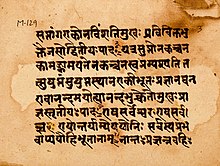Gaudapada
| Gaudapada | |
|---|---|
 | |
| Bizitza | |
| Jaiotza | VI. mendea |
| Heriotza | ezezaguna ( urte) |
| Hezkuntza | |
| Hizkuntzak | sanskritoa |
| Ikaslea(k) | |
| Jarduerak | |
| Jarduerak | filosofoa |
| Sinesmenak eta ideologia | |
| Erlijioa | Advaita Vedanta |
Gauḍapāda (Sanskrito: गौडपाद) edo Gauḍapādācārya, (India, VI. mendea) Erdi Aro goiztiar Hindua, filosofoa, Advaita Vedanta eskolakoa. [1][2] Bere biografiaren xehetasunak zalantzazkoak diren arren, bere ideiek beste batzuk inspiratu zituzten, hala nola Adi Shankara, Paramaguru (maisu altuena) deitu baitzion.
Gaudapada Karika artelanaren egile edo konpiladorea.[3] Testuak lau kapitulu ditu (lau liburu ere baderitzo eta laugarren kapituluak terminologia budista erabiltzen du, budismoak eragina izan zuela frogatuz.[4][5]
Mandukya Karika
[aldatu | aldatu iturburu kodea]Gaudapadak liburua idatzi edo konpilatu zuen.[3] Mandukya Karika Advaita Vedantari buruzko lehen tratatu sistematikoa da, baina ez da Advaitaren ikuspegiak aurkezteko obrarik zaharrena,[3], ez eta mota bereko irakaskuntzekin Shankara aurreko lan bakarra ere. [3][6]
Edukia
[aldatu | aldatu iturburu kodea]
Gaudapadiya Karikak 215 bertso ditu, lau kapitulutan banatuta:[5]
- Lehenengo kapitulua (29 bertso) — Agama, edo Agama Prakarana (Doktrina tradizionala, Mandukya Upanishaden 12 bertso barne)
- Bigarren kapitulua (38 bertso) — Vaitathya Prakarana
- Hirugarren kapitulua (48 bertso) — Advaita Prakarana (Dualtasunik eza).
- Laugarren kapitulua (100 bertso) — Alatasanti Prakarana (Su-markaren bakea)
Kronologikoki, Hajime Nakamuraren arabera, Gaudapada Karikasengandik aipatzen diren testu budistek adierazten dute lehen hiru kapituluetako ideia vedanikoak zaharragoak direla.[3]
Erreferentziak
[aldatu | aldatu iturburu kodea]- ↑ Potter 1981.
- ↑ TRV Murti (1955), The central philosophy of Buddhism, Routledge (2008 Reprint), ISBN 978-0-415-46118-4, page 114
- ↑ a b c d e Nakamura 2004.
- ↑ TRV Murti (1955), The central philosophy of Buddhism, Routledge (2008 Reprint), ISBN 978-0-415-46118-4, pages 114-115
- ↑ a b Gaudapada, Devanathan Jagannathan, University of Toronto, IEP
- ↑ Sharma, C. (1997). A Critical Survey of Indian Philosophy, Delhi: Motilal Banarsidass, ISBN 81-208-0365-5, p. 239
Ikus, gainera
[aldatu | aldatu iturburu kodea]Kanpo estekak
[aldatu | aldatu iturburu kodea]- Gaudapada Karika, Charles Johnstonen itzulpena eta iruzkina.
- Gaudapada
- Mandukya Upanishad Gaudapadako Karikarekin
- PJ Mazumdar, Gaudapadako Karika Mandukya Upanishaden
Text is available under the CC BY-SA 4.0 license; additional terms may apply.
Images, videos and audio are available under their respective licenses.
